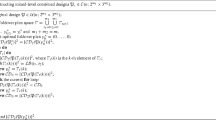Abstract
Supersaturated designs (SSDs) offer apotentially useful way to investigate many factors with only a few experiments during the preliminary stages of experimentation. A popular measure to assess multilevel SSDs is the E(χ2) criterion. The literature reports on SSDs have concentrated mainly on balanced designs. For s-level SSDs, the restriction of the number of runs N being only a multiple of s is really not required for the purpose of use of such designs. Just like when N is a multiple of s and the design ensures orthogonality of the factor effects with the mean effect, in the case of N not a multiple of s, we ensure near orthogonality of each of the factors with the mean. In this article we consider s-level E(χ2)-optimal designs for N ≡ n (mod s), 0 ≤ n ≤ s − 1. We give an explicit lower bound on E(χ2). We give the structures of design matrices that attain the lower bounds. Some combinatorial methods for constructing E(χ2)-optimal SSDs are provided.
Similar content being viewed by others
References
Booth, K. H. V., and D. R. Cox. 1962. Some systematic supersaturated designs. Technometrics, 4, 489–495.
Box, G. E. P., and R. D. Meyer. 1986. An analysis for unreplicated fractional factorials. Technometrics, 28, 11–18.
Bulutoglu, D. A., and C. S. Cheng. 2004. Construction of E(s 2)-optimal supersaturated designs. Ann. Stat., 32, 1662–1678.
Bulutoglu, D. A., and K. J. Ryan. 2008. E(s 2)-optimal supersaturated designs with good minimax properties when N is odd. J. Stat. Plan. Inference, 138, 1754–1762.
Chai, F. S., K. Chatterjee, and S. Gupta. 2009. Generalized E(s 2) criterion for multilevel supersaturated designs. Commun. Statist. Theory Methods, 38, 1–11.
Butler, N. A., R. Mead, K. M. Eskridge, and S. G. Gilmour. 2001. A general method of constructing E(s 2)-optimal supersaturated designs. J. R. Stat. Soc. B, 63, 621–632.
Chen, J., and M. Q. Liu. 2008. Optimal mixed-level supersaturated design with general number of runs. Stat. Probab. Lett., 78, 2496–2502.
Cheng, C. S. 1997. E(s 2)-optimal supersaturated designs. Stat. Sinica, 7, 929–939.
Das, A., A. Dey, L. Y. Chan, and K. Chatterjee. 2008. On E(s 2)-optimal supersaturated designs. J. Stat. Plann. Inference, 138, 3749–3757.
Fang, K. T., D. K. J. Lin, and M. Q. Liu. 2003. Optimal mixed-level supersaturated design. Metrika, 58, 279–291.
Fang, K. T., D. K. J. Lin, and C. X. Ma. 2000. On the construction of multi-level supersaturated designs. J. Stat. Plan. Inference, 86, 239–252.
Li, W. W., and C. F. J. Wu. 1997. Columnwise-pairwise algorithms with applications to the construction of supersaturated designs. Technometrics, 39, 171–179.
Li, P. F., M. Q. Liu, R. C. Zhang. 2004. Some theory and the construction of mixed-level supersaturated designs. Statist. Probab. Lett., 69, 105–116.
Lin, D. K. J. 1993. A new class of supersaturated designs. Technometrics, 35, 28–31.
Lin, D. K. J. 1995. Generating systematic supersaturated designs. Technometrics, 37, 213–225.
Liu, Y., and A. Dean. 2004. k-circulant supersaturated designs. Technometrics, 46, 32–43.
Liu, Y., and D. K. J. Lin. 2009. Construction of optimal mixed-level supersaturated designs. Stat. Sin., 19, 197–211.
Liu, Y., M. Q. Liu, and R. C. Zhang. 2007. Construction of multi-level supersaturated design via Kronecker product. J. Stat. Plan. Inf., 137, 2984–2992.
Lu, X., W. Hu, and Y. Zheng. 2003. A systematic procedure in the construction of multi-level supersaturated designs. J. Stat. Plan. Inf., 115, 287–310.
Lu, X., Y. Sun. 2001. Supersaturated design with more than two levels. Chin. Ann. Math. Ser. B, 22, 183–194.
Mukerjee, R., and C. F. J. Wu. 1995. On the existence of saturated and nearly saturated asymmetrical orthogonal arrays. Ann. Stat., 23, 2102–2115.
Nguyen, N. K. 1996. An algorithmic approach to constructing supersaturated designs. Technometrics, 38, 69–73.
Nguyen, N. K., and C. S. Cheng. 2008. New E(s 2)-optimal supersaturated designs obtained from incomplete block designs. Technometrics, 50, 26–31.
Ryan, K. J., D. A. Bulutoglu. 2007. E(s 2)-optimal supersaturated designs with good minimax properties. J. Stat. Plan. Inference, 137, 2250–2262.
Satterthwaite, F. E. 1959. Random balance experimentation. Technometrics, 1, 111–137.
Suen, C. Y., and A. Das. 2010. E(s 2)-optimal supersaturated designs with odd number of runs. J. Stat. Plan. Inference, 140.
Tang, B., and C. F. J. Wu. 1997. A method for constructing supersaturated designs and its E(s 2)-optimality. Can. J. Stat., 25, 191–201.
Wu, C. F. J. 1993. Construction of supersaturated designs through partially aliased interactions. Biometrika, 80, 661–669.
Wu, C. F. J., and M. Hamada. 2000. Experiments: Planning, analysis and parameter design optimization. New York: Wiley.
Xu, H., and C. F. J. Wu. 2005. Construction of optimal multi-level supersaturated designs. Ann. Stat., 33, 2811–2836.
Yamada, S., Y. T. Ikebe, H. Hashiguchi, and N. Niki. 1999. Construction of three level supersaturated design. J. Stat. Plan. Inference, 81, 183–193.
Yamada, S., D. K. J. Lin. 1999. Three-level supersaturated designs. Stat. Probab. Lett., 45, 31–39.
Yamada, S., and T. Matasui. 2002. Optimality of mixed-level supersaturated designs. J. Stat. Plan. Inference, 104, 459–468.
Author information
Authors and Affiliations
Corresponding author
Rights and permissions
About this article
Cite this article
Chai, F.S., Chatterjee, K., Das, A. et al. Optimal Supersaturated Designs for s m Factorials in N ≢ 0 (mod s) Runs. J Stat Theory Pract 6, 169–177 (2012). https://doi.org/10.1080/15598608.2012.647577
Received:
Accepted:
Published:
Issue Date:
DOI: https://doi.org/10.1080/15598608.2012.647577



